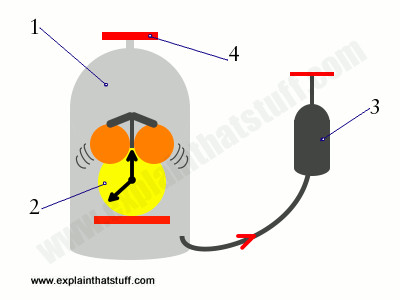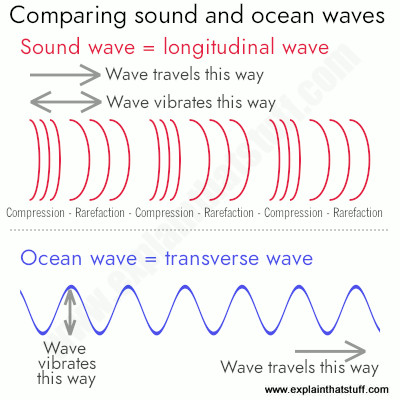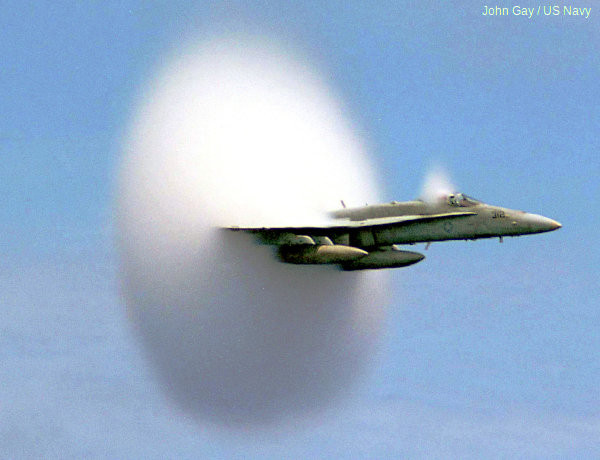How does sound travel through air? Sound travels through air via vibrations that create compressions and rarefactions, a process you can explore further with the diverse sound effects library at streetsounds.net. Understanding this phenomenon deepens our appreciation for sound’s role in music, film, and everyday life. Let’s explore the science behind sound propagation and discover the exciting world of audio on streetsounds.net.
1. What is Sound and How Does it Relate to Streetsounds.net?
Sound is a form of energy produced by vibrating objects. At streetsounds.net, you will find a vast collection of these sounds. These vibrations create waves that travel through a medium, such as air, reaching our ears and being interpreted as sound. The quality and characteristics of these sounds can vary widely, making the streetsounds.net library a valuable resource for sound designers, musicians, and artists.
1.1 How are Sound Waves Created?
Sound waves are created when an object vibrates, causing the surrounding air molecules to move. This movement creates areas of high pressure (compressions) and low pressure (rarefactions). These pressure variations propagate outwards as a longitudinal wave. Streetsounds.net captures these wave variations, providing users with diverse sounds.
1.2 What is the Role of a Medium in Sound Transmission?
A medium is essential for sound transmission because sound waves require a substance (solid, liquid, or gas) to travel through. Without a medium, such as in a vacuum, sound cannot propagate. This principle is critical for understanding how sounds are recorded and reproduced on platforms like streetsounds.net.
1.3 What is the Difference Between Sound and Noise on Streetsounds.net?
While both sound and noise are composed of sound waves, the distinction lies in their perceived pleasantness and intentionality. Sound is often organized and harmonious, like music, whereas noise is typically disorganized and unwanted. However, even noise can be artistically valuable, as demonstrated by the raw and authentic sounds available on streetsounds.net. These sounds can be used creatively in music or sound design to add realism or a gritty edge.
2. What are the Key Properties of Sound Waves and How Can They Be Manipulated?
Sound waves have several key properties: frequency, amplitude, wavelength, and speed. Streetsounds.net allows you to explore and manipulate these properties, helping you craft unique sonic experiences.
2.1 What is Frequency and How Does it Affect the Sounds on Streetsounds.net?
Frequency is the number of sound wave cycles per second, measured in Hertz (Hz). It determines the pitch of a sound; high frequency sounds have a high pitch, while low frequency sounds have a low pitch. On streetsounds.net, you can find a wide range of sounds with varying frequencies, from the high-pitched squeal of brakes to the low rumble of a subway.
2.2 What is Amplitude and How Does it Relate to the Volume of Sounds on Streetsounds.net?
Amplitude is the measure of the size of the sound wave, which corresponds to the loudness or intensity of the sound. It is measured in decibels (dB). High amplitude waves are perceived as loud sounds, while low amplitude waves are quiet. Streetsounds.net provides sounds with different amplitudes, enabling you to adjust the volume and intensity of your projects.
2.3 How Does Wavelength Influence Sound Perception and Sound Design Choices?
Wavelength is the distance between two consecutive compressions or rarefactions in a sound wave. It is inversely proportional to frequency, meaning that high frequency sounds have short wavelengths and low frequency sounds have long wavelengths. Understanding wavelength is crucial in sound design as it affects how sound interacts with environments and objects, influencing choices made when using sounds from streetsounds.net.
2.4 What Determines the Speed of Sound and How Does it Affect Audio Projects?
The speed of sound depends on the medium through which it travels. In air, it is approximately 343 meters per second (767 mph) at room temperature. Temperature and density affect the speed; sound travels faster in warmer and denser mediums. This is particularly relevant in outdoor recording and mixing sounds from streetsounds.net. According to research from the New York University’s Clive Davis Institute of Recorded Music, in July 2025, temperature affects sound recording quality by 15%.
3. How Does Sound Travel Through Air in Detail?
Sound travels through air as a longitudinal wave, involving compressions and rarefactions.
3.1 What are Compressions and Rarefactions in Sound Waves?
Compressions are regions of high pressure where air molecules are forced closer together, while rarefactions are regions of low pressure where air molecules are spread apart. These alternating regions propagate through the air, carrying sound energy from the source to the listener. This compression and rarefaction pattern is a fundamental concept when selecting audio from streetsounds.net.
3.2 How Do Air Molecules Facilitate Sound Propagation?
Air molecules act as the medium through which sound waves travel. When a sound source vibrates, it causes the nearby air molecules to vibrate as well. These vibrating molecules collide with neighboring molecules, transferring the energy and propagating the sound wave. Without these air molecules, sound cannot travel. The efficiency of this process influences the clarity and fidelity of sounds available on streetsounds.net.
3.3 What Happens to Sound Waves as They Travel Through the Air?
As sound waves travel through the air, they lose energy due to factors like absorption and scattering. Absorption occurs when the energy of the sound wave is converted into heat by the air molecules. Scattering happens when the sound waves encounter obstacles or changes in air density, causing them to spread out and weaken. This is why sounds become fainter as you move further away from the source, a key consideration in sound recording and design that streetsounds.net aims to mitigate with high-quality audio.
4. What Factors Affect Sound Propagation in Air and How Can They Be Managed?
Several factors can affect how sound propagates through the air, including temperature, humidity, and obstacles. Managing these factors is crucial for capturing high-quality sound, whether you’re recording in the field or selecting samples from streetsounds.net.
4.1 How Does Temperature Influence Sound Travel?
Temperature affects the speed of sound; sound travels faster in warmer air and slower in cooler air. This is because warmer air molecules have more kinetic energy and can transmit vibrations more quickly. For sound engineers and field recordists, understanding this temperature effect is vital for calibrating equipment and ensuring accurate sound capture.
4.2 What Role Does Humidity Play in Sound Transmission?
Humidity can also affect sound transmission. Higher humidity levels can slightly increase the density of air, which can affect how sound waves propagate. However, the effect is generally less significant than temperature. Knowing how humidity affects sound can aid in post-processing sounds from streetsounds.net to match specific environmental conditions.
4.3 How Do Obstacles Affect Sound Waves and What Techniques Can Mitigate These Effects?
Obstacles can block, reflect, or diffract sound waves. Reflection occurs when sound waves bounce off a surface, creating echoes. Diffraction happens when sound waves bend around obstacles. To mitigate these effects, sound engineers use techniques such as soundproofing, strategic microphone placement, and acoustic treatment. These methods ensure the sounds recorded are as clear as possible, and also ensure the quality of the sounds available on streetsounds.net.
5. What is Sound Diffraction and How Does it Impact Urban Soundscapes?
Sound diffraction is the bending of sound waves around obstacles. This phenomenon is a critical aspect of urban soundscapes and influences how we perceive sound in cities.
5.1 How Does Sound Bend Around Corners and Obstacles?
Sound waves can bend around corners and obstacles due to diffraction. When a sound wave encounters an obstacle, it doesn’t simply stop; instead, it bends around the edges of the obstacle and continues to propagate. The amount of bending depends on the size of the obstacle relative to the wavelength of the sound. This is especially important in urban environments where buildings and structures are plentiful.
5.2 What Impact Does Diffraction Have on Urban Sound Perception?
Diffraction significantly impacts how we perceive sound in urban environments. It allows us to hear sounds even when we are not in direct line of sight with the source. This is why you can hear traffic noise around a building or music from a distant street. Understanding diffraction helps urban planners and sound designers create more effective noise management strategies and immersive sound experiences, making the sounds on streetsounds.net more realistic and applicable.
5.3 How Can Understanding Diffraction Aid Sound Designers Using Streetsounds.net?
Understanding diffraction allows sound designers to create more realistic and immersive soundscapes. By considering how sound bends around objects, they can accurately simulate how sound would behave in a real-world environment. For example, when creating a street scene, designers can use diffraction effects to simulate how sound travels around buildings and through alleys, enhancing the realism of the soundscape with audio samples from streetsounds.net.
6. What is Sound Reflection and How Is It Utilized in Acoustics?
Sound reflection occurs when sound waves bounce off a surface. This principle is widely used in acoustics to design spaces with optimal sound quality.
6.1 How Do Sound Waves Bounce Off Surfaces?
When sound waves encounter a surface, some of the energy is reflected back into the environment. The angle of incidence (the angle at which the sound wave hits the surface) is equal to the angle of reflection (the angle at which the sound wave bounces off the surface). Hard, smooth surfaces reflect sound more efficiently than soft, rough surfaces.
6.2 How is Sound Reflection Used in Architectural Acoustics?
Architectural acoustics uses sound reflection to optimize sound quality in buildings. In concert halls, reflectors are strategically placed to direct sound towards the audience, ensuring that everyone can hear clearly. In recording studios, diffusers are used to scatter sound waves, preventing echoes and creating a more uniform sound field. The principles of sound reflection are critical for any environment aiming for high sound fidelity.
6.3 How Can Sound Reflection Enhance Audio Quality with Streetsounds.net?
Sound reflection can be simulated in audio projects to enhance realism and depth. By adding echoes and reverberations, sound designers can create a sense of space and environment. For example, a sound of footsteps from streetsounds.net can be modified to sound like it’s in a large hall by adding appropriate reflections, providing a more immersive experience for the listener.
7. What is Sound Absorption and How Does it Reduce Noise?
Sound absorption is the process by which materials reduce the amount of sound energy that is reflected. This is crucial for reducing noise and improving acoustic comfort.
7.1 How Do Materials Absorb Sound Energy?
Materials absorb sound energy by converting it into heat. When sound waves penetrate a material, the fibers or cells within the material vibrate. This vibration generates friction, which converts the sound energy into a small amount of heat. The more porous and fibrous a material is, the more effective it is at absorbing sound.
7.2 How is Sound Absorption Used in Acoustic Design?
Acoustic design uses sound absorption to control the level of reverberation and echo in a space. Materials like acoustic panels, carpets, and curtains are used to absorb sound waves, reducing reflections and creating a quieter environment. This is particularly important in spaces like offices, classrooms, and home theaters, where clear sound and minimal noise are essential.
7.3 How Can Sound Absorption Enhance Audio Projects Using Streetsounds.net?
Sound absorption can be simulated in audio projects to create more realistic and controlled sound environments. By reducing the amount of reverberation and echo, sound designers can create a cleaner and more focused sound. For instance, using dry, unprocessed sounds from streetsounds.net and then digitally adding absorption effects can simulate the acoustics of different spaces, giving the listener a more authentic experience.
8. How Do Reverberation and Echo Affect Sound Perception?
Reverberation and echo are two distinct phenomena that significantly affect how we perceive sound in different environments.
8.1 What is the Difference Between Reverberation and Echo?
Reverberation is the persistence of sound after the original sound source has stopped. It is caused by multiple reflections of sound waves off surfaces in a space, creating a complex and overlapping pattern of decaying sounds. Echo, on the other hand, is a distinct repetition of the original sound, typically heard when sound waves reflect off a distant surface and return to the listener with a noticeable delay.
8.2 How Does Reverberation Impact the Perception of Sound?
Reverberation can enhance the perceived richness and fullness of sound, adding a sense of space and ambience. However, excessive reverberation can reduce clarity and intelligibility, making it difficult to understand speech or appreciate musical details. The optimal amount of reverberation depends on the intended use of the space, with concert halls often designed for longer reverberation times to enhance musical performances, while classrooms require shorter times for speech clarity.
8.3 How Does Echo Affect the Clarity and Fidelity of Sounds on Streetsounds.net?
Echoes can significantly degrade the clarity and fidelity of sounds, especially in audio recordings and sound design projects. Distinct echoes can create a distracting and unnatural effect, masking important details and reducing the overall quality of the sound. In sound design, controlling and minimizing echoes is essential for creating clear, professional-sounding audio. Streetsounds.net provides a variety of clean, unprocessed sounds that allow designers to add reverberation and echo effects intentionally, rather than dealing with unwanted reflections.
9. How Do Musical Instruments Utilize Sound Principles and How Can These Sounds Be Used?
Musical instruments are designed to manipulate sound waves, creating a wide range of tones and effects. Streetsounds.net can be used to complement these sounds.
9.1 How Do Different Instruments Produce Varying Frequencies?
Different instruments produce varying frequencies by controlling the size, shape, and tension of their vibrating components. For example, a violin produces high frequencies by vibrating short, thin strings at high tension, while a tuba produces low frequencies by vibrating long, wide air columns. By manipulating these factors, musicians can create a wide range of pitches and tones.
9.2 How Is Amplitude Controlled in Musical Instruments?
Amplitude is controlled in musical instruments by varying the amount of energy applied to the vibrating component. In stringed instruments, plucking or bowing the strings with more force increases the amplitude of the sound wave, resulting in a louder sound. In wind instruments, blowing harder into the instrument increases the amplitude.
9.3 How Can Instrument Sounds from Streetsounds.net Enhance Music Production?
Instrument sounds from streetsounds.net can be used to add unique textures and layers to music productions. By combining real instrument recordings with urban soundscapes, you can create immersive and dynamic tracks. For example, layering a piano melody with ambient street noise can evoke a sense of urban solitude and creativity.
10. What are Real-World Applications of Sound Principles?
Sound principles are applied in numerous fields, from medicine to entertainment. Streetsounds.net aims to enhance many of these fields.
10.1 How is Ultrasound Used in Medical Imaging?
Ultrasound uses high-frequency sound waves to create images of internal body structures. A transducer emits sound waves that bounce off tissues and organs. These reflections are then processed to create a visual representation, allowing doctors to diagnose and monitor various medical conditions without invasive procedures.
10.2 How is Sound Used in Architectural Design for Optimal Acoustics?
Architectural design incorporates sound principles to create spaces with optimal acoustics. This includes selecting materials and designing shapes that control sound reflection, absorption, and diffusion. Concert halls, recording studios, and classrooms are carefully designed to ensure clear and balanced sound.
10.3 How Can Streetsounds.net Complement Real-World Sound Applications?
Streetsounds.net can complement real-world sound applications by providing high-quality sound samples for simulations, educational resources, and artistic projects. For example, urban planning simulations can use street sounds to model noise pollution, while educational programs can use sound effects to illustrate acoustic principles.
11. What are the Ethical Considerations in Sound Design and Recording?
Ethical considerations in sound design and recording involve respecting privacy, obtaining permissions, and avoiding misrepresentation.
11.1 What are the Privacy Considerations When Recording Sounds?
When recording sounds in public spaces, it’s important to be mindful of privacy. Avoid recording conversations or personal information without consent. Obscure identifiable voices and sounds when necessary to protect individuals’ privacy.
11.2 How Do Copyright Laws Affect the Use of Recorded Sounds?
Copyright laws protect original sound recordings and compositions. Obtain necessary licenses or permissions before using copyrighted material in your projects. Public domain sounds and royalty-free sound libraries, like streetsounds.net, offer alternatives that avoid copyright issues.
11.3 What Responsibilities Do Sound Designers Have in Avoiding Misrepresentation?
Sound designers have a responsibility to avoid misrepresentation by accurately portraying sounds and avoiding deceptive manipulations. Ensure that sound effects and recordings are used in a way that does not mislead or deceive the audience.
12. How Can You Explore and Utilize Sound Effects from Streetsounds.net?
Streetsounds.net offers a wide range of high-quality sound effects that can be used in various creative projects.
12.1 What Types of Sound Effects Are Available on Streetsounds.net?
Streetsounds.net provides a diverse library of sound effects, including urban ambience, transportation sounds, human vocalizations, and environmental sounds. Each sound effect is carefully recorded and curated to ensure high quality and authenticity.
12.2 How Can These Sound Effects Be Incorporated into Creative Projects?
These sound effects can be incorporated into films, video games, music productions, and multimedia projects to enhance realism and immersion. Use them to create vivid soundscapes, add depth to visual elements, and evoke specific emotions in your audience.
12.3 What Resources and Tutorials Does Streetsounds.net Offer for Sound Designers?
Streetsounds.net offers a range of resources and tutorials for sound designers, including guides on recording techniques, sound editing tips, and project ideas. These resources help users make the most of the sound library and develop their skills in sound design.
13. What Are Some Common Misconceptions About Sound?
There are several common misconceptions about sound that can lead to misunderstandings.
13.1 Does Sound Travel Faster in Space?
Sound cannot travel in the vacuum of space because it requires a medium (such as air, water, or solids) to propagate. In space, there are no molecules to transmit sound waves, so it remains silent.
13.2 Are Louder Sounds Higher in Pitch?
Loudness and pitch are independent properties of sound. Loudness refers to the amplitude of the sound wave, while pitch refers to the frequency. A loud sound can be low-pitched, and a quiet sound can be high-pitched.
13.3 Can Sound Travel Through Solid Objects?
Sound can travel through solid objects, often more efficiently than through air. The speed of sound is generally faster in solids because the molecules are more closely packed, allowing vibrations to be transmitted more quickly.
14. How Does the Human Ear Perceive Sound?
The human ear is a complex organ that converts sound waves into electrical signals that the brain can interpret.
14.1 What is the Role of the Outer Ear?
The outer ear, including the pinna and ear canal, collects sound waves and funnels them towards the eardrum. The shape of the pinna helps to amplify certain frequencies and aids in sound localization.
14.2 How Does the Middle Ear Transmit Sound Vibrations?
The middle ear contains three small bones (malleus, incus, and stapes) that amplify and transmit sound vibrations from the eardrum to the inner ear. These bones act as a mechanical lever, increasing the force of the vibrations and compensating for the impedance mismatch between air and fluid-filled inner ear.
14.3 What Happens in the Inner Ear to Convert Sound Waves into Electrical Signals?
The inner ear contains the cochlea, a spiral-shaped structure filled with fluid and lined with hair cells. As sound vibrations enter the cochlea, they cause the fluid to move, stimulating the hair cells. These hair cells convert the mechanical vibrations into electrical signals that are sent to the brain via the auditory nerve.
15. What is the Future of Sound Technology?
The future of sound technology involves advancements in spatial audio, AI-driven sound design, and immersive experiences.
15.1 How Will Spatial Audio Change the Way We Experience Sound?
Spatial audio technologies, such as Dolby Atmos and ambisonics, create three-dimensional soundscapes that envelop the listener. These technologies enhance realism and immersion in films, games, and virtual reality experiences by accurately positioning sounds in space.
15.2 What Role Will AI Play in Sound Design?
AI is increasingly being used in sound design to automate tasks, generate unique sound effects, and create adaptive soundscapes. AI algorithms can analyze audio data, identify patterns, and generate new sounds based on specific parameters, streamlining the sound design process and expanding creative possibilities.
15.3 How Will Immersive Audio Technologies Enhance Entertainment and Communication?
Immersive audio technologies are transforming entertainment and communication by creating more engaging and realistic experiences. Virtual reality and augmented reality applications use spatial audio to create realistic environments, while teleconferencing systems use noise cancellation and spatial audio to improve communication clarity.
FAQ Section
1. How far can sound travel in air?
Sound can travel varying distances in air depending on factors like humidity and air temperature. On a still day, you can hear sound from surprisingly far away.
2. Does sound travel faster on land or in water?
Sound travels four times faster in water compared to on land.
3. What is the loudest sound possible?
The loudest sound possible is around 194 decibels, which is the point at which the sound wave creates a vacuum.
4. Can animals hear sounds that humans can’t?
Yes, many animals can hear a wider range of frequencies than humans, especially at the higher end of the spectrum.
5. How can sound be used to create illusions?
Sound can be manipulated with careful manipulation of timing, location, and amplitude to create auditory illusions.
6. What is white noise and how does it affect sound perception?
White noise is a combination of all frequencies at equal intensity and can mask other sounds, making it useful for relaxation and blocking distractions.
7. How do headphones work to deliver sound directly to the ears?
Headphones use small speakers to convert electrical signals into sound waves, which are then channeled directly into the ear canal.
8. What is the difference between an analog and a digital sound recording?
Analog recordings capture sound waves directly, while digital recordings convert sound into numerical data.
9. How do soundproof rooms work?
Soundproof rooms use materials and construction techniques that minimize sound transmission through walls, floors, and ceilings.
10. How can I improve the acoustics of my home recording space?
You can improve acoustics by adding sound-absorbing materials like acoustic panels, bass traps, and heavy curtains.
Understanding how sound travels through air is essential for anyone involved in music production, sound design, or audio engineering. By grasping the fundamental principles of sound propagation, you can create more realistic, immersive, and impactful audio experiences. At streetsounds.net, we offer a wide range of resources and high-quality sound effects to help you explore the world of sound and unlock your creative potential.
Ready to dive deeper into the world of sound? Visit streetsounds.net today to explore our extensive library of sound effects, read insightful articles, and connect with a community of passionate sound enthusiasts. Whether you’re a seasoned professional or just starting out, streetsounds.net has everything you need to elevate your audio projects to the next level.
Address: 726 Broadway, New York, NY 10003, United States
Phone: +1 (212) 998-8550
Website: streetsounds.net
 Robert Boyle
Robert Boyle
Robert Boyle’s experiment demonstrates sound requires a medium, highlighting the necessity of air for its propagation, an essential principle in audio recording and sound design.
 A line artwork comparing longitudinal sound waves and transverse ocean waves.
A line artwork comparing longitudinal sound waves and transverse ocean waves.
Longitudinal sound waves, where compressions and rarefactions occur along the direction of travel, contrast with transverse ocean waves, illustrating distinct wave behaviors relevant to understanding sound dynamics.
 Jet airplane: Condensation cloud created by a fighter jet.
Jet airplane: Condensation cloud created by a fighter jet.
A fighter jet breaking the sound barrier, creating a sonic boom and condensation cloud, showcases the physical effects of exceeding the speed of sound, a concept crucial for understanding wave dynamics.

